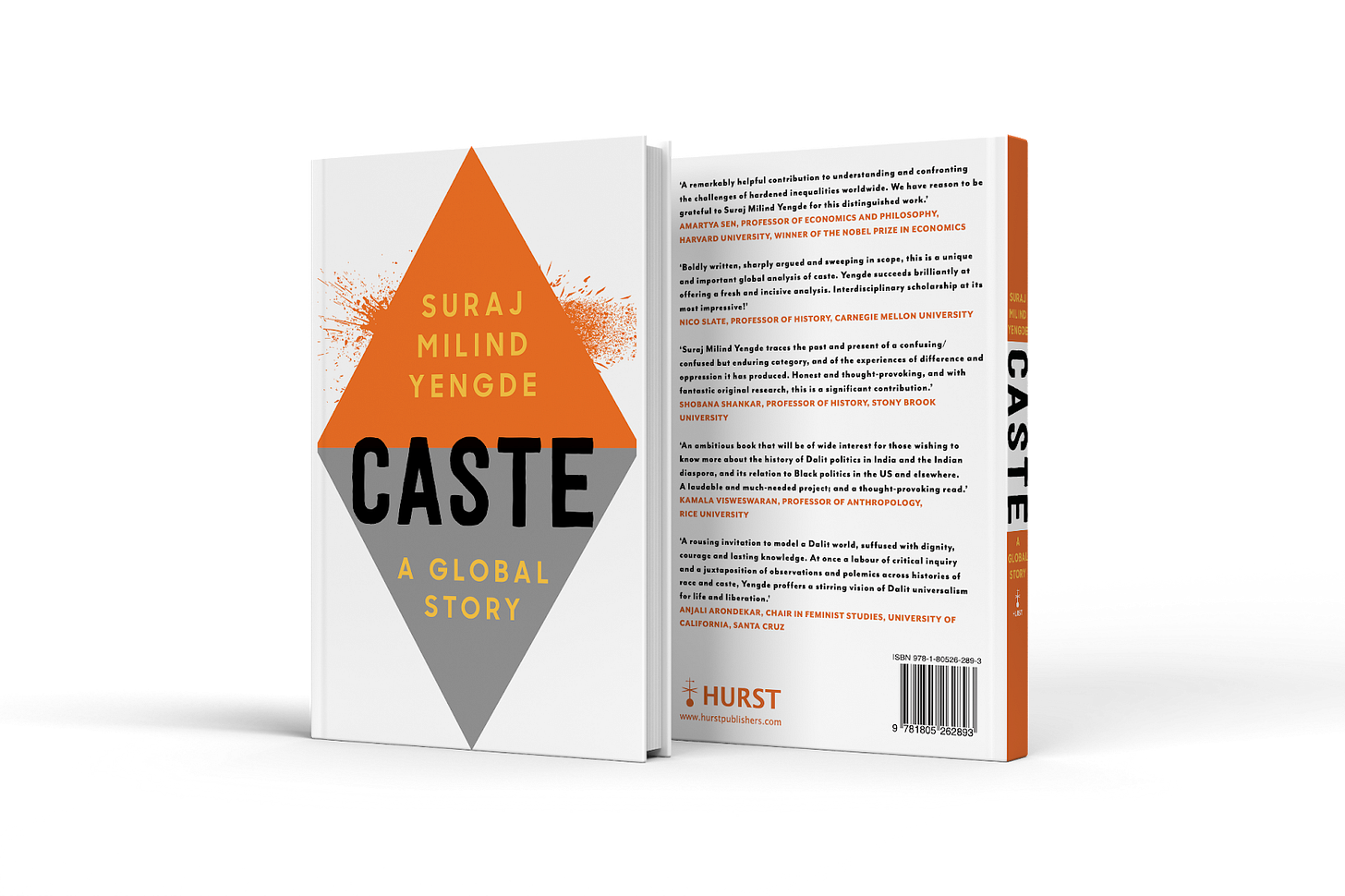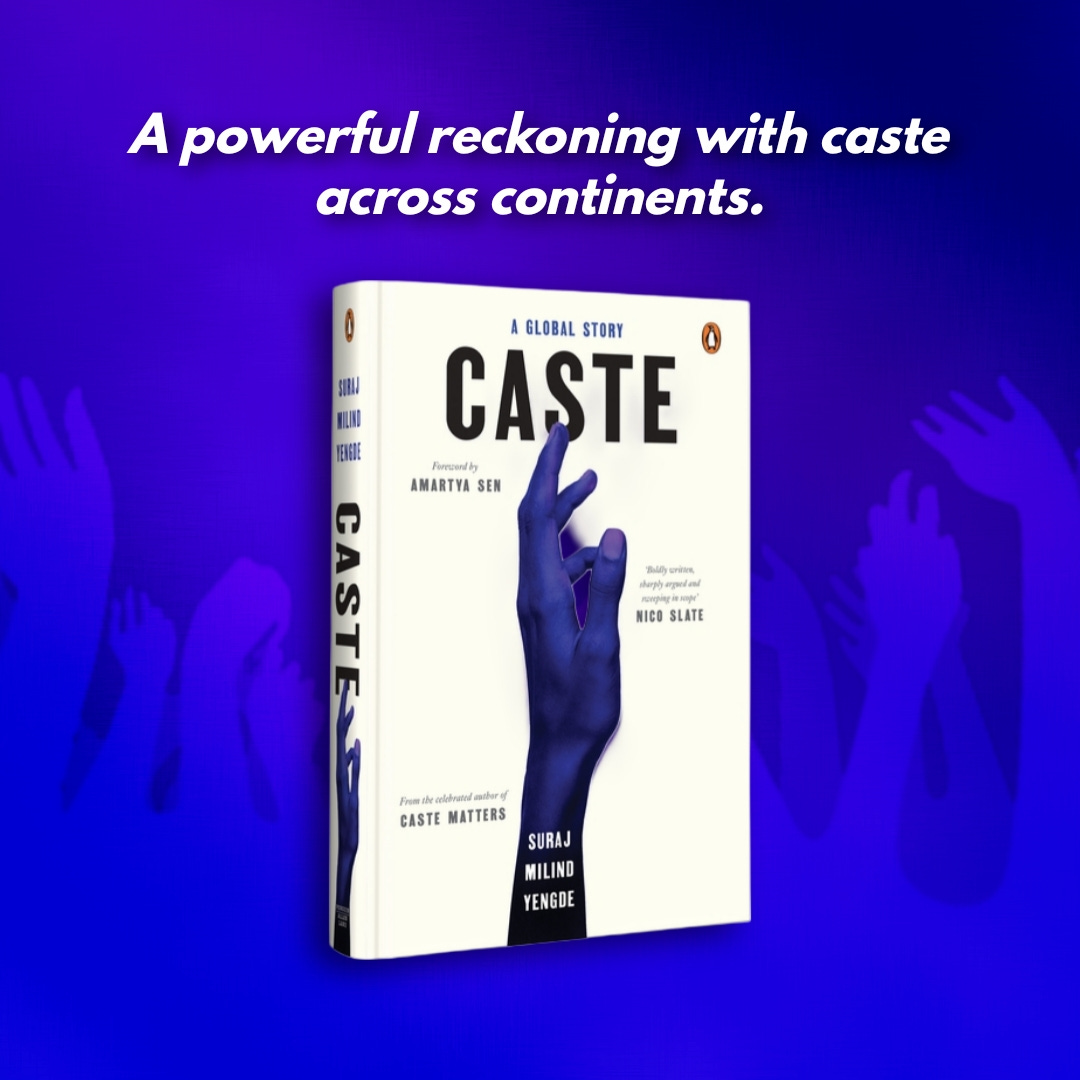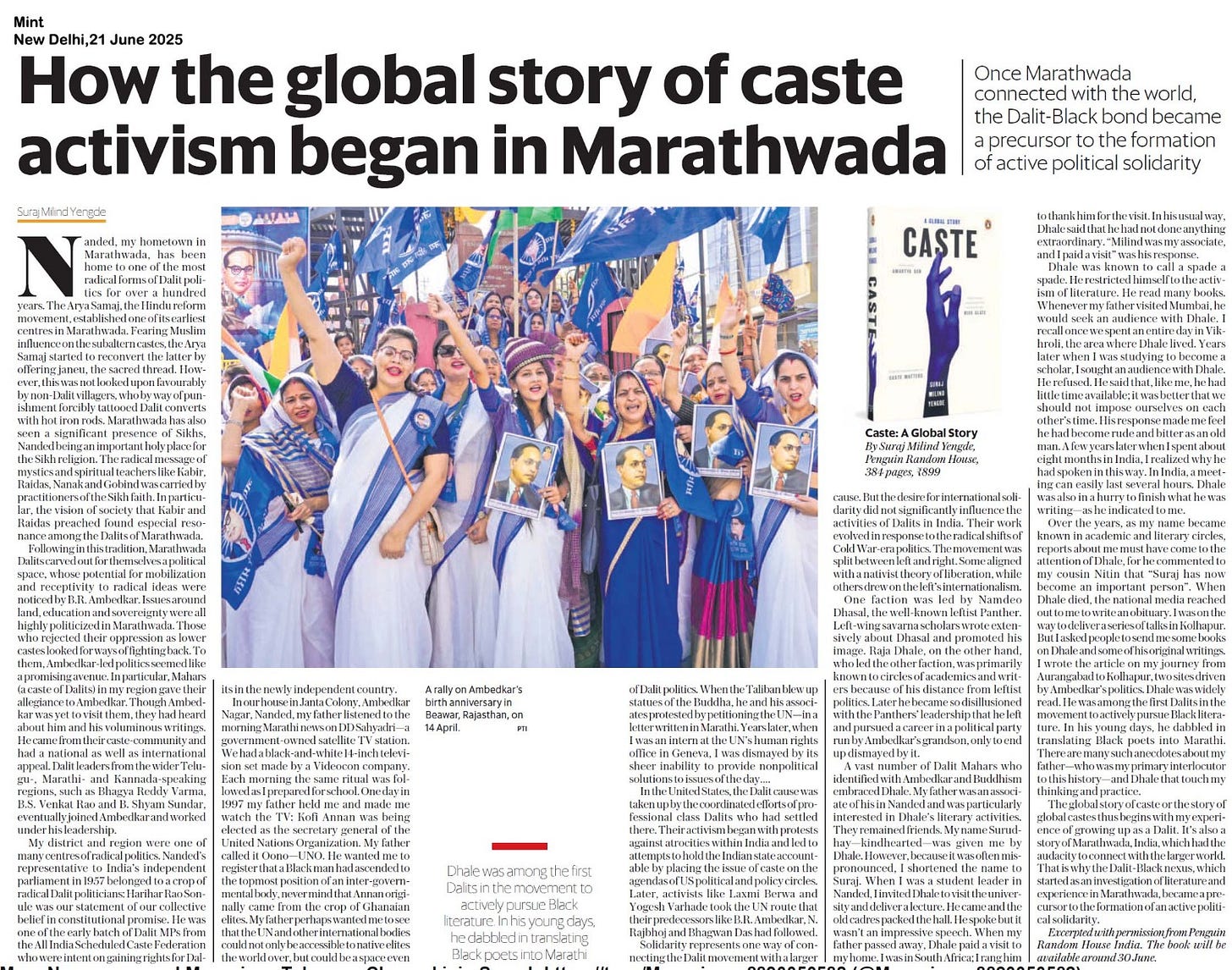Dear Friends:
Fourteen years ago, I stepped into the international anti-caste Ambedkarite movement as a student organiser in the UK. I moved from Nanded, a backwards hinterland district, to the UK, with a brief halt in Mumbai. In the UK, I met many fascinating people along the way. Activists, organisers, scholars, and advocates were creating a vision for an anti-caste society. Fifteen countries later, and ten years on, I am deeply honoured to dedicate this research to you.
Caste A Global Story is out now. It will be published in the UK, South Asia and North America. The UK edition by Hurst & Co. is gorgeous, and so is the one by Allen Lane. The blue hand on the cover is mine. Oxford University Press, NY, will print it in Fall 2025. You will hear about it closer to the date.
The book is a blend of archival and ethnographic work across the globe. I look at caste not in the siloed eyes of classical sociology, indology or anthropology of the past century. But I see how caste was understood and analysed by outsiders and insiders from ancient times to the phase of pre-Middle Ages to now. The now moment is the major focus of the work.
I had started collecting materials, not knowing where they would land. In 2015, I noticed the project’s potential when I moved to the US and got involved in the contemporary Dalit diasporic activities as well as social movements led by progressive and black people. I was on the streets alongside them. It took ten long years of gathering clay from many oceans to finally shape this work.
The chapters don't just focus on the historiography of castes but also deal with real evidence of the caste system and the practices seen worldwide. I test the hypothesis of what happens to castes when they migrate out of India: does it retain its value, or does it disappear? The research took me to a faraway island of Trinidad, where I spent time among the Indian communities.
Trinidad and the Caribbean, in general, have produced tremendous research on the interactions between society, religion, ethnicity, and politics of racial grouping. However, no study has looked at the question of caste from a subaltern experience or an anti-caste point of view. It is one of the fundamental causes of the migration story and the settlement of new nations in the West Indies.
The findings are very interesting, and I can't wait for you to meet the protagonists that I introduce in the book. One is Pandit Amar Sreeprasad, whose forebearers had come to work on the plantation sites. Many generations later, he still carries the stigma of being an Ahir, a peasant caste. Pandit Amar is defiant, carries the inheritance of his ancestors, and challenges the Brahminical orthodoxy by becoming a non-Brahmin priest.
Progressive-minded people welcome it. Even the RSS affiliate representatives in Trinidad find it appropriate for Pandit Amar to have his congregation, but what does Pandit Amar have to say about this? We shall read this in a multi-year ethnography combined with archival registers of the Caribbean.
The book is not just about Trinidad but also about caste reconstructed through the experience of foreigners, from the Greeks to Arabs to the British. It also looks at the influence of Dalit literature and their approach to the Black literature of America. Another chapter critically examines the often-spoken Dalit-Black solidarity and what it actually was. Another chapter looks at what I call Cosmopolitan Dalit Universalism, examining the Dalit labour in the diaspora and emerging economies. I report on the lives of Dalit labourers in the Middle East, where I visited their camps and interviewed them in secrecy.
I am humbled by the love and support the book has already received. Nobel Prize winner and the idol of many in my generation, Amartya Sen, has written a foreword to the book. Endorsement from folks whose work I strive to emulate is a privilege.
Sen writes, “the book is also based on Yengde’s well-researched knowledge of caste practices around the world, as well as his direct observations in many of the affected countries. Each country can learn from one another’s experience in the manifestation and attempted remediation of caste-based discrimination.”
Many share the credit for it is not solely mine. I am profoundly grateful to all who held my hand, corrected me, humbled me, taught me, and loved my passion. This book is as much yours as it is mine.
The acknowledgements say it all. You shall hear from me soon. I dedicate the book to “Yengdes, and my mentors, whose legacy I inherit.”
Those in the UK, Europe can order here. Those in India and South Asia can order here. I am eager to share this work with you as I gift these ideas to the world. I hope you will continue to shower me with your generous support, as you have been doing for so long. I am deeply grateful to you and humbled by all.
Below is an excerpt published in Mint Lounge.
The Indian Express carried an excerpt entitled, “The parallels between Dalit movement in India and US’ Black movement” that covered the history of the Dalit etymology and the political struggle that gave Dalits an identity of global significance. There are interesting histories of the evolution of the Dalit identity and politics since the 1920s, which is undergoing change till the present. Read more about it here.
The Hindustan Times announced the arrival of Caste.
In News
Conference
3rd Dr Ambedkar International Convention, Paris
Just recently, I was in Paris to attend the 3rd Ambedkar International Convention. The Parisian team of Ambedkarites who primarily hold affiliation to the Bahujan movement and have been cadres of Kanshi Ram have been doing the conference regularly. I had missed the earlier two editions, and this time, since I was in Europe, I made it.
It was a diverse mix of European-Ambedkarite crowd who had driven from nearby countries. The conference was primarily led by the BSP base. The chief speakers were Dr Avtar Singh Karimpuri, a former Rajya Sabha MP of the BSP and current head of the Punjab state. He spoke about the “unity of mind”, which he positioned as an ideal to work in the community. I found this idea very stimulating. In the Indian political space, especially among Dalits, there is always a hue and cry about the lack of unity among Dalits. Dr Karimpuri provided an insight into forging unity on an intellectual level, convincing the mind. Then the paths will be easier for diverse actors to partake in the movement.
The lone MLA in the Punjab Assembly, Dr Nacchatar Pal of the Nawashahr Constituency, reported on the activities taken by him in the Assembly. The Worldwide BSP Supporters coordinator, Amar Daroch, also spoke on the implications of supporting BSP candidates in India. He appealed to the audience from European countries who were in attendance to select one constituency and support them during the elections. He pointed out the 2 lakh crore budget of Punjab. He compared the astronomical amount to individuals who may be millionaires, but could not match the state budget. Thus, he urged people to aim for the bigger portion.
I spoke about the limitations of movements that get swayed by blind followers and untrained cadres. I urged the political movements to make use of new technologies such as AI and incorporate them in their operations. I also made a point that I have been trying to publish the speeches and writings of Kanshi Ram, but due to the rights issue, the project has been set aside. Who has the rights to Kanshi Ram's writings? Is it his family or the party? The opinions differ, and the legal framework for copyright has something else to say. I also pointed out that those who are expelled from BSP should have a space to exist rather than entirely disowning them. To err is human, and to rectify the mistakes is also human. One of the strengths of the BSP is its strict discipline and intolerance of corruption, betrayal of trust and mismanagement of party office. However, at times, these also act in a bad light when accusations do not hold weight. My speech made the BSP leaders uncomfortable, and they asked the organiser on the stage to come over in an attempt to stop me from speaking on this point.
One of the highlights of this conference, to me, was the involvement of the second generation. The host, Parminder Singh, had his son Amit actively involved in arranging the affairs of the conference. Since he is a French-born person, his English and Hindi were compromised. Yet, he spoke fluent Punjabi and French. Another Lal Singh, whose 26-year-old daughter is a bank manager in Paris. She has been actively pursuing her Punjabi heritage and also the Dalit history. I was ecstatic to see such a resounding contribution from the second-gen Ambedkarites.
World Conference for a Caste-Free World, Toronto 2025
Earlier this month, I was in Toronto to attend the “World Conference for a Caste-Free World”. It was a gathering led by Nepali intellectuals and activists. I have always been impressed by the scale of work done by Nepali brothers and sisters. The Nepali Dalit struggle is comparatively successful due to the lobbying done by revolutionary thinkers and leaders across the political spectrum. Though they are not treated equally, their struggle have resonance. They got the Nepali government to acknowledge caste at the UN forums and have resorted to commit to its annihilation. This is not shamefully done by the Indian government. The Toronto conference released a 17-point Declaration. Read about the conference in Nepal News.
Congratulations,
The current edition of the Berlin Biennale has featured artworks by Vikrant Bhise. The curator, Sumesh Sharma, writes of the “impressive scale of his work and the gathering of human bodies venerates the idea of pacifist civil disobedience, while recalling the first march to annihilate caste.” Read my review of Vikrant's work here.
Salik Ansari, a Bhiwandi resident, is an artist who finds radiance amidst state violence. His art captures the mundane that is political with seething numbness of the resigned public. His work at the Biennale presents the half-baked, invisibilized portraits that appear undone. But they are in the silhouette of the vertical angle held against the popular perception. When he draws a truck of migrants, we don't see people but only the truck's interior. One is invited to guess the people, and in a moment of revelation, they show up in the messier arcs of parts of the bodies.
He curates a burning pyre without fire. The fire is the rising flame in everyone. Salik provides the spatial intensity for the dragon to blaze hellfire.
Salik is an Ansari, a broader term to locate his social caste of subordination among the Islamic brotherhood that got corrupted to the antecedent values of graded hierarchy. These are people whose etymological history originates in the Arab land and gets choreographed as an artisanal profession among the Sunni heritage of Mohammad's descendants.
Read about his work here.
Things to look out for
I am curious about AI and would want to master this new technology before it befools me. I stumbled upon this piece in the New York Times at the Munich airport that looks at the possibilities of different jobs that AI may create. These are mostly supervisory roles that hold the leash of the AI behaviour and correct it. The parables are incentivising, but it does not offer more at the moment. The kind of jobs AI would create sounds like another chain of clerical peasantry tied to the fiefdom of technological satraps. Read the piece by Robert Capps here.
Poykayil Appachan, one of the fiercest anti-caste leaders of Kerala land was also a renowned pacifist who rallied for peace at a time when walking on the streets of Kerala was unwelcome. Now his followers have followed suit to protest against the war in the Middle East. You can read more about it here.
Jason Stanley’s talk at PPF’s Raosaheb Kasabe Distinguished Lecture On History
It is now available to read at Himal Magazine. Himal is an erudite publisher in South Asia. They truly carry the tag of being a South Asianist in their approach and coverage.
Read the complete lecture “How fascism works in India” here
In History
01 June – The famous tract, "Gulamgiri" — “Slavery in the Civilised British Government under the Cloak of Brahmanism”, was published in 1873 by Jotirao Phule.
03 June – Mayawati, the first Dalit woman, became the head of the state as Chief Minister of Uttar Pradesh in 1995.
09 June – Death anniversary of Birsa Munda, the respected Tribal leader of India.
19 June – Formation of Milind College in Aurangabad by Dr Ambedkar in 1950.
20 June – Siddharth College, Mumbai, was established by Dr Ambedkar in 1946.
24 June – Birth anniversary of Kabir, the eternal and radical saint of the Middle Ages.
26 June – Birth anniversary of Shahu, the monarch of Kolhapur state (1874).
Jai Bhim from a 32-degree Celsius Europe for now. #DalitLove, #CasteIsGlobal,
suraj.
https://linktr.ee/surajyengde || www.surajyengde.com
Order a copy of Caste A Global Story here ( for the UK, Europe, US) & here (for India and South Asia).
















